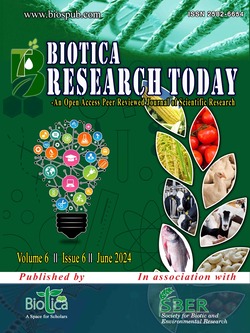
Overview of Indian Sericulture: Types, Production and Economic Significance
Ankush Subhash Gadge*
Central Silk Board, Research and Extension Centre, Aurangabad, Maharashtra (431 003), India
Ashok Limbaji Jadhav
Central Silk Board, Research and Extension Centre, Parbhani, Maharashtra (431 402), India
Pushpalatha, M.
Dept. of Entomology, Post Graduate Institute, Mahatma Phule Krishi Vidyapeeth, Rahuri, Maharashtra (413 722), India
Megaladevi, P.
Central Silk Board, Central Sericultural Research & Training Institute, Mysuru, Karnataka (570 008), India
Sowmiya, K.
Central Silk Board, Central Sericultural Research & Training Institute, Mysuru, Karnataka (570 008), India
DOI: NIL
Keywords: Mulberry, Silk, Textile, Vanya
Abstract
Silk, known as the "Queen of Textiles," is a natural fiber produced in over 60 countries, with India as the biggest consumer and second-largest producer. The five commercial silks, Muga, Eri, Oak Tasar, Tropical Tasar and Mulberry are exclusively produced in India, each from different silkworm species. The sericulture industry in India employs 8.8 million people and generated Rs. 1,848.96 crores (US$ 248.56 million) in export earnings in 2021-22. Mulberry silk, from Bombyx mori, constitutes the majority of production, with Karnataka, Andhra Pradesh, Tamil Nadu, West Bengal, Maharashtra, Telangana, Uttar Pradesh and Jammu & Kashmir producing 92% of it. In 2022-23, India produced 36,582 MT of silk, with mulberry silk at 27,654 MT. Jharkhand, Orissa and Chhattisgarh make tasar silk, while Oak Tasar comes from sub-Himalayan regions. Eri silk, from Philosamia ricini, is prominent in the Northeastern states and Muga silk, from Antheraea assamensis, is unique to Assam. India's cultural and traditional market strengthens its global silk industry presence.
Downloads
not found
Reference
Bhattarcharjya, D., Alam, K., Bhuimali, A., Saha, S., 2020. Status, potentials, constrains and strategies for development of sericulture farming system in West Bengal state of India. Bulgarian Journal of Agricultural Science 26(4), 709-718.
Central Silk Board (CSB), 2024. Sericulture. In: Central Silk Board, Ministry of Textiles, Govt. of India (website). Available at: http://csb.gov.in/silk-sericulture/sericulture/. Accessed on: 17th May, 2024.
Goel, R.K., 2017. Temperate tasar culture. In: Industrial Entomology. (Ed.) Omkar. Springer, Singapore. pp. 321-344. DOI: https://doi.org/10.1007/978-981-10-3304-9_11.
International Sericulture Commission (ISC), 2024. Statistics. In: International Sericulture Commission, United Nations (website). Available at: https://www.inserco.org/en/statistics. Accessed on: 17th May, 2024.
Yokoyama, T., 1963. Sericulture. Annual Review of Entomology 8, 287-306. DOI: https://doi.org/10.1146/annurev.en.08.010163.001443.
